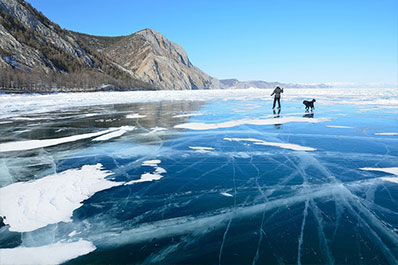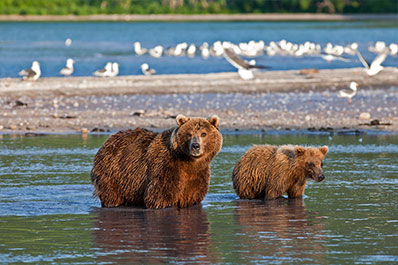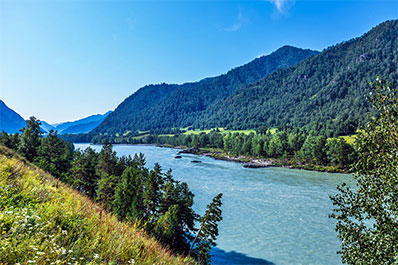Russia is a wild land. Its vast territory spans tundra, taiga, forest, steppe and dessert. It boasts the world’s largest area of uninhabited wilderness, the world’s deepest lake, Europe’s highest mountain and, unsurprisingly, the world’s coldest permanent human settlement. If you dream of stepping where no man has stepped before, Russian adventure tourism is for you.
Adventures Like No Other in Russia:
- Long Journeys: Trains and river cruises provide a unique an often exhilarating way to see Russia’s lesser known regions.
- Extreme Sports: Mountain hiking, heli-skiing, snowmobiling and sledding are just some of the amazing outdoor activities in Russia. Come in winter to be able to experience adventure tourism in Russia at its best.
- Wildlife Watching: Russia has rightly earned its reputation as the land of bears, but did you also know that it has the world’s largest reindeer population?
- Natural Wonders: The world’s deepest lake, a valley where all animals perish and a mountain that towers over all of Europe; these are just some of the gems that make Russia a global destination for adventure tourism.
Once in a Lifetime Journeys
Trains
Stretching nine time zones, travel takes on a whole new meaning in Russia. People talk of travel times in days, not hours. Whereas in Europe weekend city breaks are the norm, in Russia it could take as long as a week simply to get to the destination. The journey itself becomes an adventure. Due to the impressive railway lines that were laid down under the imperial rule, to this day train travel is the main form of long-distance transport. Indeed, so central is it to Russian life that train travel has become part of the culture. Though tourists tend to take the Trans-Siberian, which is the longest and perhaps most famous train journey in the world, there are hundreds of other rail routes for the intrepid traveller to take.
River Cruises
The hypnotic, rhythmic plodding of the song of the Volga Boatmen perfectly encapsulates what it’s like to sail down Europe’s greatest river. If Russia ever were to have a pilgrimage, this would be it. Though steadily sailing from the north-western forested hills between Moscow and St Petersburg to the sultry Caspian Sea, may not be a physical adventure per say, it is a undoubtedly a journey filled with cultural and spiritual excitement. At almost every bend in the river, the imposing walls of some historic city’s kremlin, such as Kazan or Nizhny Novgorod, rises up from the banks. And, amid reclusive forests brushing against the water, the golden, onion domes of centuries-old monasteries gleam in the sun.
Outdoor sports
Heli-skiing
When people think of Russia they think of snow, but fire is as plentiful as ice in Russia’s most remote eastern region; Kamchatka. With over 300 snow-capped volcanoes rising above jagged bays, skiing here is not for the light-hearted. But, for the true adrenaline seeker, being dropped by a helicopter onto perfectly powdered slopes stretching down to the Pacific Ocean is an experience like no other.
Hiking
Europe’s highest mountain is not in the Alps, but rather in the Caucasus on the border between Russia and Georgia. At 5,642 meters it is a mammoth climb. Thankfully, one doesn’t need to be Hercules to appreciate its height; a train and ski-lift carry visitors up to almost 4,000 meters.
Sledding
Troikas aren’t only found in fairytales. As soon as the snow is thick enough, horse-drawn sleighs heaped in lavish furs trail along many a park in Russia’s suburbia. Less well-known, but no less fun are the vatrushkas (doughnut-shaped sleds) that zip down dizzyingly high, traditional wooden slides during the New Year’s holidays. For families whith young children, Russia in winter is the perfect destination for an adventure holiday.
Snowmobiles
Feet don’t get you far in Russia’s vast land. This fact becomes painfully true when the snow gets meters deep. Though most ordinary Russians opt for cross-country skis to get around, it isn’t the most exciting or indeed effective way to explore Russia in winter. Instead, try a snowmobile tour and hear your soul sing as the engine roars. If you go far enough North, you may be lucky enough to see polar bears or the Northern lights.
Wildlife Watching
Bears
The bear has long been the symbol of Russia and rightly so. Russia has an estimated 120,000 wild bears; compared to America’s 50,000 it is by far the country with the most bears. In the far east region of Kamchatka, the salmon is so numerous that rivers appear to be red from a distance and bears simply need to dip their paws into the water to catch their dinner. With such a rich diet, Kamchatka bears are the world’s second largest brown bear, weighing in at 650kg (only 50kg less than the fearsome Kodiak bear). They are also the most prolific; Kamchatka has the world’s highest density of bears which means sightings are practically guaranteed. Though the relatively gentle giants don’t tend to attack unless forcefully provoked, bear tours must be conducted with armed guides by law.
Reindeer
In northern Siberia, the world’s largest reindeer population of around 1 million deer are herded in extraordinarily large groups by the native nomads. Living in yurts and swathed from head to toe in reindeer skin, their way of life has changed very little over the centuries. Discover the bond humans can have with nature by visiting and even migrating with Russia’s reindeer herders through the breathtaking tundra.
Natural Wonders
Northern lights
With a good chunk of Russia in the Arctic circle, there isn’t a better country in which to see the Northern lights work their magic. Murmansk is the best place to go and, unlike in the nordic countries, you won’t be surrounded by hundreds of tourists snapping their cameras away - indeed, you might be the only one for miles around!
Lake Baikal
The world’s deepest and most mysterious lake needs no introduction. Come rain, snow or shine it’s a magnificent place to visit and, unlike most of Russia’s other natural wonders, it’s relatively accessible, being just a short drive from the chief Siberian city and a stop on the Trans-Siberian railway; Irkutsk. In winter, photographers and extreme sports lovers come from far and wide to marvel at its crystal-clear ice formations and to feel the thrill of hiking, running, riding, skating or even cycling on ice. Summer is the time for tourists. Smiling and exceptionally chubby Baikal seals pose on the beaches along with dozens of Russians seeking the sun and fresh forest air. Apart from swimming, people come to Baikal to explore and forage in the pristine forests, visit the ancient buddhist shrines on the shore and sail the great expanse of the lake on cruises.
Kamchatka
The most eastern tip of Russia is closer to America than Moscow. Despite its remote location, it’s one of the most famous nature destinations in Russia. Swept by the icy winds of the Pacific, this rugged landscape of snow-capped volcanoes looks onto the world’s second largest bay. To appreciate the scale of Avacha bay, consider that all the world’s ships could fit into the bay with space to spare for its UNESCO heritage site, the Three Brothers (a massive rock formation jutting out the water). Just a few kilometres inland lies another unique heritage site. In a valley only accessible by helicopter, the world’s second highest concentration of geysers makes for an otherworldly combination of smoke, volcanoes and lakes literally teeming with bears (it’s not uncommon for more than a dozen to be sighted in just one spot!). In this region guides aren’t a luxury, but rather a necessity; the carcass strewn Valley of Death, which seeps out toxic concentration of sulphurous gas, lies dangerously close by.
City Adventures
White nights
Sometimes to experience the extraordinary, you don’t need to travel far. In Russia’s most breathtaking city - St Petersburg - summer brings with it one of the most magical natural phenomena: the white nights. From May till July, the enchanting glow of twilight which usually only lasts a few fleeting minutes stretches on for hours. Time looses all meaning when days go on for 18 hours and where the night sky is as blue as day. In St Petersburg there are many reasons to wish that a day would last for infinity and, with the white nights, that wish can at least partly come true.
Roof top climbing
Since Catherine the Great ordered that no building in St Petersburg could be built higher than the Hermitage, the cityscape has been kept uniquely low. Even St Petersburg’s residents, who have to pay eye-wateringly high property prices due to this restriction, are thankful for the stunning views this 18th century law has made. To enjoy unobstructed panoramas of this ancient city, conquer the peaks of St Petersburg’s tin roofs on a roof top tour. It may not be as physically exerting as climbing Mt. Elbrus, but it certainly will release just as much adrenalin considering that almost all tours are semi-illegal!
Soviet secrets
Eighteen stories under Moscow’s busting streets, the big red button that was meant to start WW3 still glows ominously. A warren of tunnels and rooms was dug in secret at the height of the Cold War. Named Bunker 42, it was meant to be the hide-away of the USSR’s ruling elite in case of nuclear war. Exploring this Terra Incognita, with the KGB’s interrogation rooms and the screeching sound of Moscow’s metro above, will have your hairs stand on their ends. But, be warned, this is an adventure in every sense of the word: visitors will have to climb all 18 stories if they wish to leave!




